OCD治疗实践指南(APA2007,郭中孟)
- 格式:ppt
- 大小:2.67 MB
- 文档页数:77
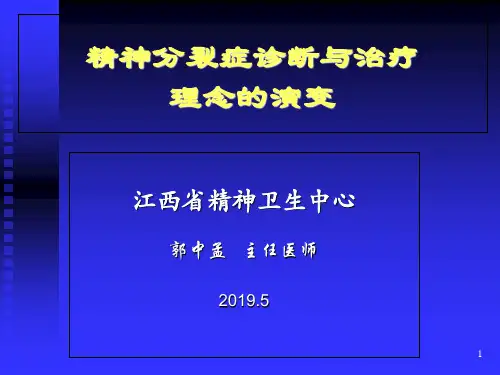
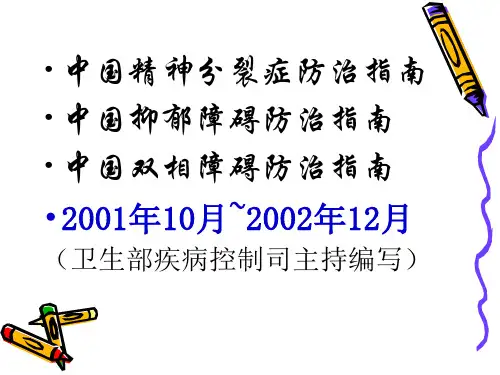
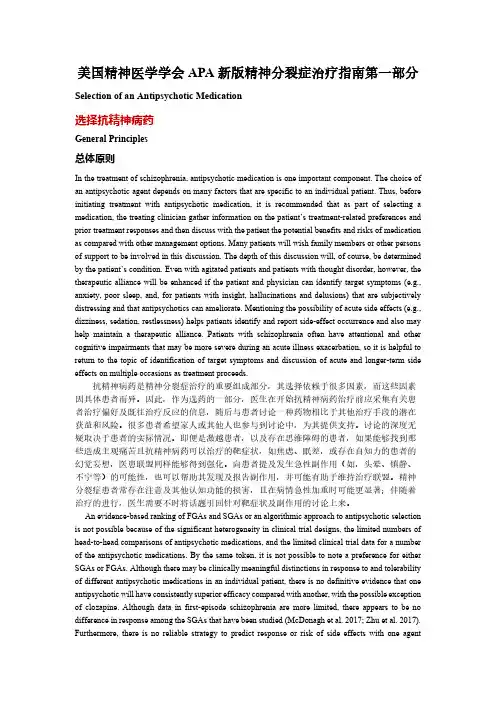
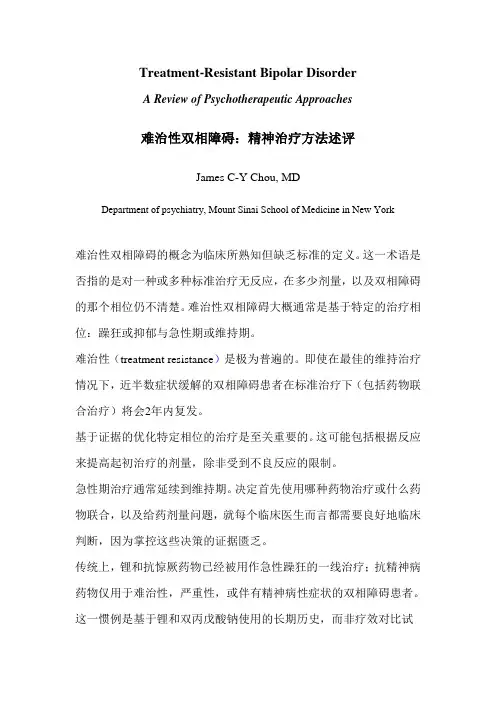
Treatment-Resistant Bipolar DisorderA Review of Psychotherapeutic Approaches难治性双相障碍:精神治疗方法述评James C-Y Chou, MDDepartment of psychiatry, Mount Sinai School of Medicine in New York难治性双相障碍的概念为临床所熟知但缺乏标准的定义。
这一术语是否指的是对一种或多种标准治疗无反应,在多少剂量,以及双相障碍的那个相位仍不清楚。
难治性双相障碍大概通常是基于特定的治疗相位:躁狂或抑郁与急性期或维持期。
难治性(treatment resistance)是极为普遍的。
即使在最佳的维持治疗情况下,近半数症状缓解的双相障碍患者在标准治疗下(包括药物联合治疗)将会2年内复发。
基于证据的优化特定相位的治疗是至关重要的。
这可能包括根据反应来提高起初治疗的剂量,除非受到不良反应的限制。
急性期治疗通常延续到维持期。
决定首先使用哪种药物治疗或什么药物联合,以及给药剂量问题,就每个临床医生而言都需要良好地临床判断,因为掌控这些决策的证据匮乏。
传统上,锂和抗惊厥药物已经被用作急性躁狂的一线治疗;抗精神病药物仅用于难治性,严重性,或伴有精神病性症状的双相障碍患者。
这一惯例是基于锂和双丙戊酸钠使用的长期历史,而非疗效对比试验。
得到FDA批准的非典型抗精神病药物用于双相障碍的使用范围正在扩展;这些药物当前被认为是即使对于适度躁狂患者是一线治疗。
为了快速地减少难治性和提高病情稳定性,必须关注共病,例如物质滥用。
而且,必须停用使病情不稳定的药物治疗,例如抗抑郁药物。
基于证据的加强心理治疗在维持期显然是有益的。
对于确实难治性状况,也推荐氯氮平和电休克治疗(ECT)用于急性期和维持期的抑郁和躁狂治疗。
如果这些治疗失败,有人提出许多新型疗法,而且有一些已经在安慰剂对照试验中得到研究。

美国精神医学学会APA新版精神分裂症治疗指南中英文对照版第三部分Monitoring During Treatment With an Antipsychotic Medication抗精神病药治疗期间的监测During treatment with an antipsychotic medication, it is important to monitor medication adherence, therapeutic benefits of treatment, and treatment-related side effects. The patient’s clinical status can also be affected by changes in physical health, adjustments to other psychotropic and nonpsychotropic medications, and other factors, such as cessation or resumption of smoking.使用抗精神病药期间,监测用药依从性、疗效获益及治疗相关副作用非常重要。
患者的临床状态也可能受躯体健康状况、其他精神科药物及非精神科药物,以及停止/重新开始吸烟等因素的影响。
Adherence to antipsychotic treatment is a common problem that affects treatment outcomes. There are many barriers to treatment adherence as well as facilitators and motivators of adherence, each of which will differ for an individual patient (Hatch et al. 2017; Kane et al. 2013; Pyne et al. 2014). Thus, it is important to take a patient-centered approach in inquiring in a nonjudgmentalway whether the individual has experienced difficulties with taking medication since the last visit. (For a detailed discussion of factors related to adherence, see Statement 3.)抗精神病药治疗依从性是影响治疗转归的常见因素。

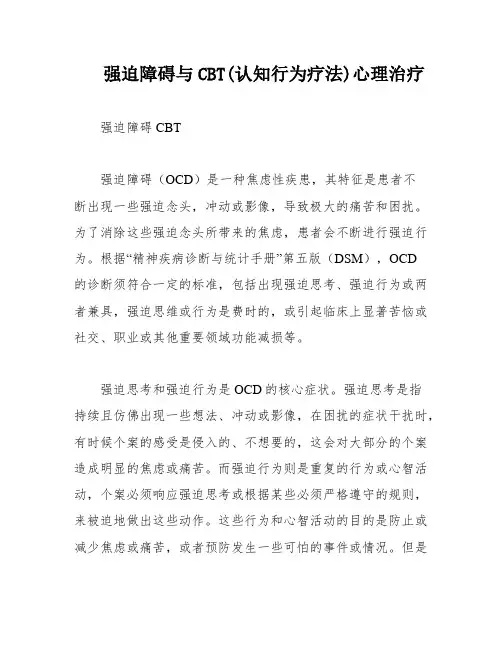
强迫障碍与CBT(认知行为疗法)心理治疗强迫障碍CBT强迫障碍(OCD)是一种焦虑性疾患,其特征是患者不断出现一些强迫念头,冲动或影像,导致极大的痛苦和困扰。
为了消除这些强迫念头所带来的焦虑,患者会不断进行强迫行为。
根据“精神疾病诊断与统计手册”第五版(DSM),OCD的诊断须符合一定的标准,包括出现强迫思考、强迫行为或两者兼具,强迫思维或行为是费时的,或引起临床上显著苦恼或社交、职业或其他重要领域功能减损等。
强迫思考和强迫行为是OCD的核心症状。
强迫思考是指持续且仿佛出现一些想法、冲动或影像,在困扰的症状干扰时,有时候个案的感受是侵入的、不想要的,这会对大部分的个案造成明显的焦虑或痛苦。
而强迫行为则是重复的行为或心智活动,个案必须响应强迫思考或根据某些必须严格遵守的规则,来被迫地做出这些动作。
这些行为和心智活动的目的是防止或减少焦虑或痛苦,或者预防发生一些可怕的事件或情况。
但是这些行为或心智活动,与其期望去抵消或预防的现实状况是不符合和的,或显然是过度的。
OCD的强迫思考的类型包括攻击、怕受污染、性、囤积(或节省)和宗教等。
攻击类型的强迫思考表现为害怕伤害自己或别人,或做出令自己无法控制的事情;怕受污染类型的强迫思考表现为怕脏、怕触摸、怕清洁剂、化学药品等各种污染物;性类型的强迫思考表现为出现不合理的性画面或思考,如对自己的小孩性侵犯;囤积(或节省)类型的强迫思考表现为认为每样东西都很重要,舍不得丢掉,因此堆积很多东西;宗教类型的强迫思考表现为担心冒犯神明,或担心道德上的对错。
XXX是一种有效的治疗OCD的方法。
XXX的基本思想是通过改变患者的思维和行为,来减轻他们的症状。
XXX的治疗过程包括认知重构、暴露和反应防御预防等。
认知重构是指帮助患者识别和改变他们的负面思维模式,以减少强迫思考的出现。
暴露是指让患者面对他们的恐惧和焦虑,并逐渐适应这些情境,以减少强迫行为的出现。
反应防御预防是指帮助患者学会有效地应对强迫念头和行为,以减少其对生活和职业的影响。
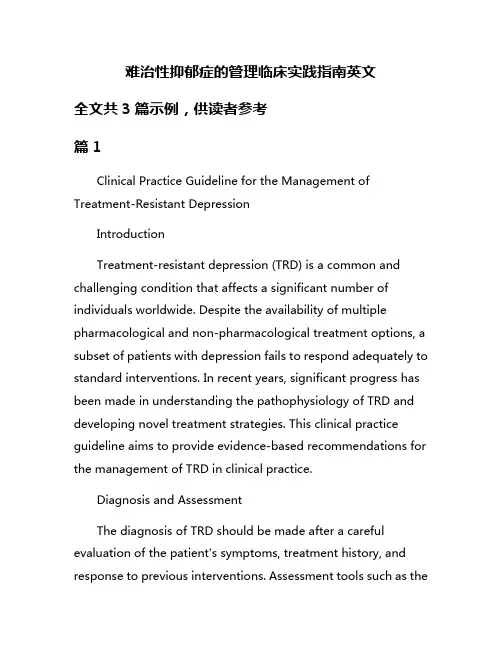
难治性抑郁症的管理临床实践指南英文全文共3篇示例,供读者参考篇1Clinical Practice Guideline for the Management of Treatment-Resistant DepressionIntroductionTreatment-resistant depression (TRD) is a common and challenging condition that affects a significant number of individuals worldwide. Despite the availability of multiple pharmacological and non-pharmacological treatment options, a subset of patients with depression fails to respond adequately to standard interventions. In recent years, significant progress has been made in understanding the pathophysiology of TRD and developing novel treatment strategies. This clinical practice guideline aims to provide evidence-based recommendations for the management of TRD in clinical practice.Diagnosis and AssessmentThe diagnosis of TRD should be made after a careful evaluation of the patient's symptoms, treatment history, and response to previous interventions. Assessment tools such as theHamilton Depression Rating Scale (HDRS) and the Montgomery-Åsberg Depression Rating Scale (MADRS) can be used to evaluate the severity of depressive symptoms. In addition, a comprehensive psychiatric evaluation should be conducted to rule out other psychiatric disorders that may mimic depression or contribute to treatment resistance.Pharmacological InterventionsFor patients with TRD, pharmacological interventions remain the mainstay of treatment. Antidepressant medications such as selective serotonin reuptake inhibitors (SSRIs),serotonin-norepinephrine reuptake inhibitors (SNRIs), and tricyclic antidepressants (TCAs) are commonly used in the management of TRD. In cases where patients do not respond to first-line antidepressants, switching to another class of antidepressants or augmenting with other medications such as atypical antipsychotics, lithium, or thyroid hormones may be considered.PsychotherapyIn addition to pharmacological interventions, psychotherapy can also play an important role in the management of TRD. Cognitive-behavioral therapy (CBT), interpersonal therapy (IPT), and mindfulness-based interventions have been shown to beeffective in treating depression and improving treatment outcomes in patients with TRD. Psychotherapy can be used as a standalone treatment or in combination with pharmacotherapy to enhance the effectiveness of treatment.Electroconvulsive Therapy (ECT)Electroconvulsive therapy (ECT) is a highly effective treatment option for patients with severe TRD who have not responded to pharmacological or psychotherapeutic interventions. ECT is typically reserved for patients with severe depressive symptoms, psychotic features, and suicidal ideation. ECT has been shown to produce rapid and sustained improvements in mood and is considered safe andwell-tolerated in the majority of patients.Ketamine and Other Novel Treatment ApproachesKetamine, a glutamatergic modulator, has emerged as a promising treatment for TRD. Intravenous ketamine administration has been shown to produce rapid antidepressant effects in patients with TRD, with improvements observed within hours of treatment. Other novel treatment approaches such as transcranial magnetic stimulation (TMS), vagus nerve stimulation (VNS), and deep brain stimulation (DBS) are also being investigated as potential options for patients with TRD.ConclusionIn conclusion, the management of TRD requires a comprehensive and individualized approach that takes into account the patient's symptoms, treatment history, and preferences. This clinical practice guideline providesevidence-based recommendations for the management of TRD and highlights the importance of a multidisciplinary approach involving psychiatrists, psychologists, and other healthcare professionals. By implementing these recommendations in clinical practice, healthcare providers can improve treatment outcomes and quality of life for patients with TRD.篇2Clinical Practice Guidelines for the Management of Treatment-Resistant DepressionIntroductionTreatment-resistant depression (TRD) is a challenging condition characterized by a lack of response to standard antidepressant therapy. It is estimated that up to 30% of patients with depression do not adequately respond to initial treatment, and a proportion of these individuals may go on to develop TRD. Management of TRD requires a comprehensive approach thatincludes a combination of pharmacological andnon-pharmacological interventions. This document provides evidence-based recommendations for the management of TRD in clinical practice.Diagnostic EvaluationThe first step in managing TRD is to ensure an accurate diagnosis. This involves a thorough assessment of the patient's history, symptoms, and response to previous treatments. It is important to rule out other psychiatric or medical conditions that may be contributing to the treatment resistance. A comprehensive evaluation should also include a review of the patient's medication history, substance use, and psychosocial stressors.Pharmacological InterventionsWhen managing TRD, it is important to consider switching to a different antidepressant medication or augmenting with an additional agent. Some common strategies include:- Switching to a different class of antidepressant- Augmenting with a second-generation antipsychotic- Augmenting with a mood stabilizer- Adding a stimulant medication- Considering off-label use of ketamine or esketamineNon-Pharmacological InterventionsIn addition to pharmacotherapy, non-pharmacological interventions can play a valuable role in the management of TRD. These may include:- Cognitive-behavioral therapy (CBT)- Interpersonal therapy (IPT)- Mindfulness-based therapies- Electroconvulsive therapy (ECT)- Transcranial magnetic stimulation (TMS)- Vagus nerve stimulation (VNS)Treatment SettingPatients with TRD may benefit from treatment in a specialized mental health setting, such as a mood disorders clinic or an inpatient psychiatric unit. These settings provide access to a multidisciplinary team of mental health professionals who can collaborate on the patient's care. In severe cases, hospitalizationmay be necessary to ensure the safety and stability of the patient.Monitoring and Follow-UpRegular monitoring of symptoms and treatment response is essential in the management of TRD. Clinicians should closely monitor the patient's mood, energy level, appetite, and sleep patterns. It is important to assess for potential side effects of medications and to address any concerns or barriers to treatment compliance. Follow-up appointments should be scheduled at regular intervals to assess the effectiveness of the treatment plan and make adjustments as needed.ConclusionManaging TRD requires a comprehensive and individualized approach that addresses both pharmacological andnon-pharmacological interventions. By followingevidence-based guidelines and collaborating with a multidisciplinary team of mental health professionals, clinicians can help patients with TRD achieve remission and improve their quality of life.篇3Management Clinical Practice Guidelines forTreatment-Resistant DepressionIntroductionTreatment-resistant depression (TRD) is a challenging condition that affects a significant number of individuals worldwide. It is characterized by persistent symptoms of depression despite multiple treatment attempts with various antidepressant medications. Managing TRD requires a comprehensive approach that goes beyond traditional pharmacotherapy and includes psychotherapy, lifestyle modifications, and other interventions. This clinical practice guideline aims to provide healthcare professionals with evidence-based recommendations for the management of TRD.Assessment and DiagnosisThe first step in managing TRD is an accurate assessment and diagnosis. This includes a thorough evaluation of the patient's history, symptoms, and potential contributing factors. It is essential to rule out other medical conditions that may be causing or exacerbating the symptoms of depression. In addition, a comprehensive mental health assessment, including a psychiatric evaluation, should be conducted to determine theseverity of the depression and identify any comorbid psychiatric disorders.Treatment OptionsOnce a diagnosis of TRD has been established, treatment options should be tailored to the individual patient's needs. Pharmacotherapy remains a cornerstone of TRD treatment, with options including switching to a different antidepressant medication, adding a second medication, or trying a combination of medications. It is essential to monitor the patient closely for side effects and treatment effectiveness.In addition to pharmacotherapy, psychotherapy is an essential component of TRD management. Cognitive-behavioral therapy (CBT) has been shown to be effective in treating TRD by helping patients identify and change negative thought patterns and behaviors. Other types of therapy, such as interpersonal therapy (IPT) and psychodynamic therapy, may also be beneficial for some patients.Lifestyle modifications, such as exercise, diet, and sleep hygiene, can also play a significant role in managing TRD. Regular physical activity has been shown to improve mood and reduce symptoms of depression, while a healthy diet and adequate sleep can support overall mental health.Other treatment options for TRD include neuromodulation techniques, such as transcranial magnetic stimulation (TMS) and electroconvulsive therapy (ECT). These treatments are typically reserved for patients who have not responded to other interventions and may be effective in severe cases of TRD.Follow-Up and MonitoringRegular follow-up and monitoring are essential for patients with TRD to ensure treatment effectiveness and detect any potential side effects. Healthcare professionals should schedule regular appointments with patients to assess their symptoms, medication compliance, and overall well-being. It is crucial to involve the patient in treatment decision-making and encourage open communication about treatment outcomes.ConclusionManaging TRD requires a multidisciplinary approach that addresses the complex nature of the condition. This clinical practice guideline provides evidence-based recommendations for healthcare professionals to effectively manage TRD and improve patient outcomes. By utilizing a combination of pharmacotherapy, psychotherapy, lifestyle modifications, and other interventions, healthcare professionals can help patients with TRD achieve remission and regain their quality of life.。
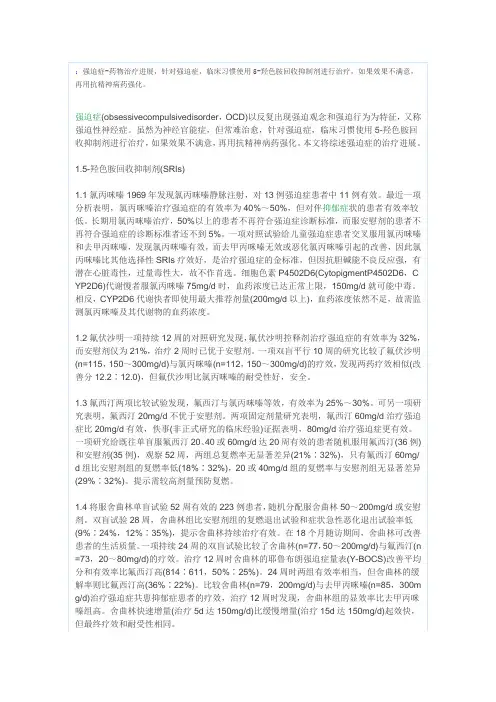

强迫症文献综述一、定义强迫症(OCD)属于焦虑障碍的一种类型,是一组以强迫思维和强迫行为为主要临床表现的神经精神疾病,其特点为有意识的强迫和反强迫并存,一些毫无意义、甚至违背自己意愿的想法或冲动反反复复侵入患者的日常生活。
患者虽体验到这些想法或冲动是来源于自身,极力抵抗,但始终无法控制,二者强烈的冲突使其感到巨大的痛苦和焦虑,影响学习工作,人际交往甚至生活起居。
近年来统计数据提示强迫症的发病率正在不断攀升,有研究显示普通人群中强迫症的终身患病率为1%~2%,约2/3的患者在25岁前发病。
强迫症因其起病早、病程迁延等特点,常对患者社会功能和生活质量造成极大影响,世界卫生组织(WHO)所做的全球疾病调查中发现,强迫症已成为15~44岁中青年人群中造成疾病负担最重的20种疾病之一。
另外患者常出于种种考虑在起病之初未及时就医,一些怕脏、反复洗手的患者可能要在症状严重到无法正常生活后才来就诊,起病与初次就诊间可能相隔十年之久,无形中增加了治疗的难度,因此我们应当提高对强迫症的重视,早发现早治疗。
二、病因1、心理学机制1.1 OCD的人格特征:庞道记等圈在研究中则更具体地说明了OCD与强迫人格有一定关系,并提示,OCD患者有抑郁情绪。
缺乏自信.焦虑、紧张、追求完美、不安全、敏感多疑、不适应、自卑、自责、强迫观念、刻板等,与强迫人格突出表现不安全感、不完善感、小心多疑、尽善尽美、优柔寡断.既严于律己又苛求别人,做事一丝不苟,难得通融等的观点一致。
另外,OCD患者人格特征除了强迫人格外,常常共患其他类型的人格障碍史尧胜摘译的“强迫症与人格障碍的共病”中指出,OCD不伴人格障碍是少见的亚型,绝大部分临床病例共患人格障碍,最常见的为强迫型、回避型和偏执型人格障碍。
王振等研究则发现,共患人格障碍与OCD的难治性可能有一定关系。
从有关研究中OCD患者MMPI基本量表的因子分析结果可以看出,OCD主要负荷4个人格因子,即神经质:反映患者具有神经症性症状;精神质:反映患者存在严重的不能适应现实的心理特征,具有精神病性症状;多疑因子:反映患者存在敏感、多疑、情绪小稳等心理特征;社会内向因子:反映患者社交内向性、自恋、敏感被动、退缩等心理特征问。
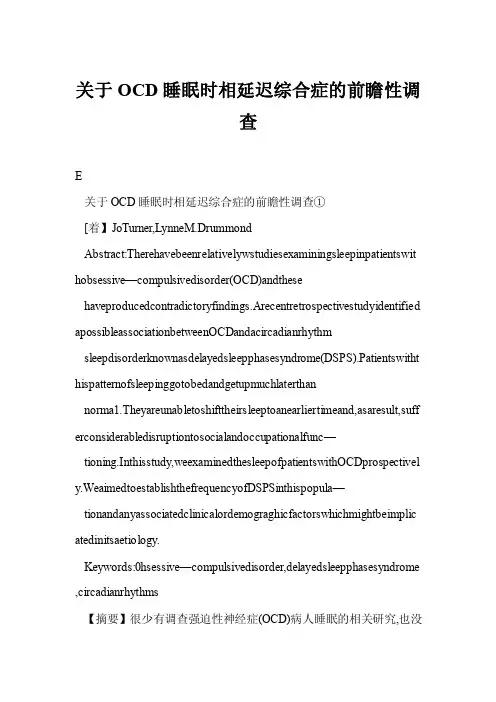
关于OCD睡眠时相延迟综合症的前瞻性调查E关于OCD睡眠时相延迟综合症的前瞻性调查①[着】JoTurner,LynneM.DrummondAbstract:Therehavebeenrelativelywstudiesexaminingsleepinpatientswit hobsessive—compulsivedisorder(OCD)andthese haveproducedcontradictoryfindings.Arecentretrospectivestudyidentified apossibleassociationbetweenOCDandacircadianrhythm sleepdisorderknownasdelayedsleepphasesyndrome(DSPS).Patientswitht hispatternofsleepinggotobedandgetupmuchlaterthannorma1.Theyareunabletoshifttheirsleeptoanearliertimeand,asaresult,suff erconsiderabledisruptiontosocialandoccupationalfunc—tioning.Inthisstudy,weexaminedthesleepofpatientswithOCDprospectivel y.WeaimedtoestablishthefrequencyofDSPSinthispopula—tionandanyassociatedclinicalordemograghicfactorswhichmightbeimplic atedinitsaetiology.Keywords:0hsessive—compulsivedisorder,delayedsleepphasesyndrome ,circadianrhythms【摘要】很少有调查强迫性神经症(OCD)病人睡眠的相关研究,也没反驳性的发现出现.近来一个回顾研究识别出OCD与生理节奏频率性睡眠障碍(即众所周知的睡眠时相延迟综合症,DSPS)间的可能关联.这种睡眠模式的病人比正常人晚睡晚起.他们不能把他们的睡眠转换到一个早一点的时间,结果,社会和职业机能都遭受到相当大的破坏.在这个研究中,我们预先调查了OCD病人的睡眠.我们旨在建立起这群人的DSPS频率,并找出有关它的病原的任何临床或人口统计学因素.【关键词】强迫性神经症睡眠时相延迟综合症生理节奏引言强迫性神经症(OCD)是一种普通的慢性失调,它会导致社会和职业机能的巨大危难和损伤.睡眠紊乱通常伴随着精神紊乱,但是很少有关于OCD中睡眠紊乱的研究.现在已有反驳性的发现出现,因为有人有睡眠紊乱,有些的睡眠模式正常.在一个FhBobdeyetal主持的研究中,非抑郁的OCD病人的睡眠模式与控制个体的模式并没有明显差异.然而,还有--d,群病人,他们比正常人晚睡晚起得多.这种延迟的睡眠模式,即众所周知的睡眠时相延迟综合症(DSPS),会导致白天昏昏欲睡,以至于工作和社会机能受到很大的破坏.这是生理节奏频率性睡眠障碍最普通的形式,它被定义作一种个人环境所要求的惯例日课表与他或她的内生生理节奏的睡眠一清醒系统间的不协调.在近来一个同顾性研究中,我们识别出OCD和DSPS间的可能关联.现在的研究旨在预先调查OCD中的睡眠模式,以建立起这群人的DSPS频率,并探究它的临床影响和有关它的病原的任何相关因素.讨论在这个研究中,42%的严重而有抵抗力的OCD病人有DSPS.有DSPS的病人绝大部分都是男性,都比睡眠时相正JI1Turner,LynneMDrummond.Aprospectivestud),ofdelayeddeepphases yndromeinpatientswithresist~nlobsessive—compulsivet|isonler.WorldPsychiatry’2007:6:4 4—47.医疗保健等县2007.9常的人年轻,OCD也更严重.除了睡眠的时间选择外,其他由PSQI或目标看护评估测量出来的睡眠参数都没有明显差异.这与Weitzman的发现一致,即DSPS的睡眠本质上是正常的,虽然时间推后.睡眠时相延迟不是由于病人难以入睡,因为由看护人员测量的睡眠潜伏期并没有明显差异.那些有DSPS的人也更不可能有固定的睡觉时间,病人自己也不把这当作晚睡的理由.这两个小组在催眠药和其他药物的使用上也类似.所有睡眠周相移位的病人都对睡眠定时表现出不满,他们也不能解释为什么会发生移位.比起那些睡眠正常的人,有DSPS的病人的社会和职业机能明显有所缺损.这是否是由于睡眠模式移位本身,又它是否反应出这组人的OCD更严重这个事实,这些都还不是很确定.DSPS在一般成人中是比较罕见的:估计只有0.17~0.72%的人有.然而,有7.3%的青少年有,而其他方面都正常的孩子中有高达10%的人有.DSPS通常是在孩童时期或青春期发作的.我们还没有发现任何性别上的差异, 44%的病人显示出家族特性.很少有调查精神紊乱病人的DSPS的相关研究.先前OCD与DSPS问的关联也没有被报导过.然而,OCD病人通常都会将他们的问题藏藏掩掩,而且一藏就是很多年.OCD 诊断也因此被忽略了.这个研究指出,DSPS是严重的慢性OCD病人的一个普通问题.一个有关类似OCD病人的回顾性研究发现,有17%的人有DSPS.在Weitzman的系列——3O个出现在失眠门诊部的有DSPS的病人中,他们发现17个病人没有精神紊乱,两个有慢性精神分裂症,一个是躁狂抑郁病紊乱,四个慢性抑郁和六个人格障碍.在对33个从某一睡眠障碍门诊部查阅到的有DSPS的病人的研究中,Regestein和Monk报导说,75%的病人是或已经是抑郁症.然而,这个结论只是基于病人当前和早先的抗抑郁病药的使用.Thorpyetal发现在22个有DSPS 的青少年中有14个存在抑郁症状,它是睡眠紊乱最主要的精神病学原因.Weitzman颠覆了这种说法,他说心理症状并不是原因,而是问题的产物,他引用了那个证据,即经过睡眠紊乱的治疗,很多DSPS病人的心理功能显示出巨大的改进. 然而,其他的研究员都支持原来的说法,即DSPS先于精神紊乱而且可能是精神紊乱的原因.Daganetal发现有DSPS的病人的人格障碍影响范围更大,并提出个体的生物钟与环境问的不协调导致了情绪和社会问题.然而,我们研究中的病人都在OCD发作后产生睡眠时相的移位.从孩童时代早期开始,不眠症和欲睡周期是由视丘下部视交叉核中的生理节奏”时钟”调节的.典型成人的内生睡眠一清醒周期稍长于24小时,因此必须每天重新安排以使它与客观的一天24小时保持一致.生理节奏时钟可通过不同的提示来调节,比如白天和黑夜的明亮一黑暗周期.明亮的光早在醒来期间就出现了,这可能引起睡眠时相提前,但是,如果出现晚了,就会引起时相延迟.社会提示(比如进餐时间和活动)也在睡眠一清醒周期的调节中起了作用,或是抵制作用或是帮助稳定时相.进食咖啡因,酒精或药物都可能导致与正常调节相冲突的结果.睡眠一清醒周期的截止是通过褪黑激素来调节的.褪黑激素分泌物是由傍晚时分El光的变暗刺激的,它在白天的强光中受到抑制.夜幕降临了,褪黑激素比欲睡发作大约早1.5—2个小时出现.不管是间接地通过褪黑激素,还是直接通过视交叉核作用,血液中的复合胺都包括在重新安排过程中.任何作用于血清素激活系统的药物都会影响睡眠一清醒周期.在一个由Hermeshetal主持的研究中,10个OCD病人在开始服用氟伏沙明后出现DSPS.在所有只服用氟伏沙明的病人中,有十分之九的病人在停止服用此药后,他们的DSPS消失了.研究员也注释说,在过去曾服用氟西汀和/或氯丙的病人中,有十分之七的病人也没有这种睡眠紊乱.研究员断定DSPS是由于氟伏沙明而不是OCD本身.造成氟伏沙明和氟西汀不同影响的可能的机制是这些药物对褪黑激素水平不同程度的影响.在我们的研究中,有DSPS的病人里面,没有人服用氟伏沙明,只有一个人服用氟西汀.有人提出说,那些出现DSPS的人这样做是因为他们不能充分地重新安排他们的生物钟.有人解释说,无法制造必E要的睡眠时相提前是因为有DSPS的个体的内生生理节奏期异乎寻常地漫长.对差不多与世隔绝的年轻人的自发性心理节奏频率的研究发现,他们大部分人的睡眠一清醒周期大约是25小时,但是一些主体的周期则长达5O个小时.个体的差异部分被基因型解释了.几种基因都包括在人类生理节奏频率的调节中,而DSPS的家族形式与或者这个或者那个时钟基因的转变相关.年龄也是一个因素.早年的内生周期较长,中年和晚年的周期慢慢缩短.这说明了为什么青少年和年轻人中有DSPS的人超乎寻常地多,我们的研究也发现有DSPS的病人都明显年龄偏小.知道了睡眠一清醒周期是怎样被调节的以后,我们可以假设一个机制,严重的OCD病人正是通过这个机制出现DSPS的.繁琐复杂的礼节致使病人们居家不出,这导致了他们不能够充分地出现在白天的日光中,这又接着导致了睡眠时相的延迟.社会的隔绝,活动的缺乏,很难规律地准备膳食等在严重的OCD病人中也很普遍,这些都是阻止平时重新安排生物钟的部分问题.也有证据证明,OCD病人的褪黑激素分泌失调.在研究13个治疗免费的OCD病人的生理节奏频率时,Monteleoneetal发现,他们的褪黑激素水平的夜间峰值明显低于控制个体,出现时间也晚了2个小时.OCD越严重的病人(Y—BOCS得分也就越高),这些差异也就越显着.褪黑激素峰值时间越后,就越容易产生睡眠时相延迟.在规则的睡眠一清醒周期中,日光和褪黑激素的重要性提出了在睡眠紊乱的OCD病人中采用外生褪黑激素治疗和/ 或日光治疗的可能性.进一步调查DSPS和OCD的生物学过程的研究已经得到批准,这使得这对两种情形进行药理学治疗成为可能.专责任编辑常海庆ghvh@163O,Om200~i9医疗保健等奥《露。
强迫障碍的认知行为治疗(案例分析)李占江教授,主任医师,博士生导师,首都医科大学附属北京安定医院副院长、临床心理学系主任、中国心理卫生协会认知行为治疗专业委员会副主任委员、亚洲认知行为治疗协会执行委员、中国医师协会精神科医师分会认知行为治疗专业委员会主任委员、中国心理卫生协会常务理事、中国睡眠研究会睡眠与心理卫生专业委员会第二届副主任委员。
【摘要】本研究使用自编强迫症认知行为治疗手册对一例强迫障碍的研究对象进行系统、规范的认知行为治疗(cognitive behavioral therapy,CBT)。
在评估研究对象强迫思维和强迫行为的基础上,针对适应不良的认知和行为问题开展14 次系统规范的CBT 治疗。
采用耶鲁⁃布朗强迫量表(Yale⁃Brown obsessive compulsive scale,Y⁃BOCS)、汉密尔顿抑郁量表(HAMD⁃17) 和汉密尔顿焦虑量表(HAMA)评估CBT 治疗前后情绪及症状的变化。
14 次CBT 治疗完成后,研究对象症状达到有效缓解,总体功能明显改善,达到了预期的治疗目标。
本研究提示,自编强迫症认知行为治疗手册在实践中是有效的,对强迫症的规范化治疗具有指导意义。
【关键词】认知行为治疗; 强迫障碍; 个案研究强迫障碍(obsessive compulsive disorder,OCD)是以反复出现且无法控制的闯入性思维、冲动、意向及强迫行为为主要症状的精神障碍。
其发展呈现慢性化、迁延不愈的特点,给患者带来极大的心理困扰。
然而OCD 确切病因尚不明确,有研究表明OCD药物治疗起效慢,副作用大,复发率高导致强迫症患者服药依从性差[1] ,一项2014 年的强迫症认知行为治疗Meta 分析表明,认知行为治疗效果优于抗抑郁药[2] ,且对药物治疗应答率不好的强迫障碍患者也是有效的[3] ,因此很多学者将强迫症的治疗方向转向认知行为治疗。
强迫障碍的认知行为治疗是指在认知行为治疗(cognitive behavioral therapy,CBT)理论模型下,通过识别并矫正功能不良思维和行为来减少症状,恢复社会功能。
强迫症患者的治疗实践指南强迫症工作组LorrinM.Koran,M.D.,Chair;GregoryL.hanna,M.D.;Eric Hollander,M.D.; Gerald Nestadt,M.D.;Helen Blair Simpson,M.D.,Ph.d.(注:本指南于2006年10月得到批准,于2007年7月出版) A部分治疗推荐Ⅰ. 实施概要A. 编码系统每一个推荐被确定为得到认可的三种类型之一,相关的推荐是基于临床可信性,接着阐述以黑体罗马字标示。
这三种类型见于如下:[Ⅰ]有确定的临床可信性推荐[Ⅱ]有中度临床可信性推荐[Ⅲ]可能是基于个体情况推荐B.实施概要1. 精神病学处理临床实践中所见的强迫症(OCD)通常是慢性波动性病程。
当OCD症状影响功能或导致显著痛苦时则需要治疗[Ⅰ]。
精神病学处理包括提供给现有OCD患者在其疗程中的大量治疗行为,与患者个体的需求,接受能力,渴求强烈一致[Ⅰ]。
重要的是患者的需要要与医生的治疗(药物治疗,其它临床医生和社会机构例如学校和职业康复项目)相结合[Ⅰ]。
当OCD达到致残性严重程度,精神病学专家可能需要为了患者写信给政府机构控制残疾收益方法,政策上为卫生保健提供资金,或政府支持提供住房;或对当局、立法机关、学校或雇主征税[Ⅰ]。
患有OCD的年幼孩子的父母可能需要忠告有关OCD的遗传危险。
对于临床医师来说,重要的是向这些患者解释,可利用的资料显示儿童罹患OCD的患者在增加,但有不过分的危险;患者希望得到更多的信息可能是遗传咨询。
a. 建立治疗联盟建立和保持一种强有力的治疗联盟是重要的,以便治疗是共同性的,并且因此也更有效,更有计划性和更能完成[Ⅰ]。
朝着这一目标的步骤包括调整交流方式来满足患者的需求和接受能力,可以通俗易懂的言语解释症状,以及对患者进行鼓励和安慰。
过分的怀疑是OCD的特征,可能需要特殊的方法来建立治疗联盟,包括允许患者有充分的时间来考虑治疗决定和重复解释(有限的几次)[Ⅰ]。
氟伏沙明血浆浓度和成人患者的OCD症状/缓解Donatella Marazziti*, Stefano Baroni, Gino Giannaccini, Armando Piccinni, Michela Picchetti, Gabriele Massimetti, Elisa Schiavi, Lionella Palego 和Mario Catena-Dell’Osso目的本研究中,我们探讨氟伏沙明血浆浓度与成人强迫症(OCD)患者(采用该药物治疗6个月)的临床特征和/或缓解之间可能的关系。
方法本研究共纳入20例已采用氟伏沙明(平均剂量±SD:216.7±86.2)治疗至少4周的OCD 门诊男女患者。
采用Yale—Brown强迫症量表(Y-BOCS)评估OCD的严重程度。
采用高效液相色谱法分析法测定氟伏沙明血浆浓度。
所有评定均在服用氟伏沙明4周(t1)和6个月(t2)后进行。
结果氟伏沙明血浆浓度在两个评估时间点保持稳定,无性别差异。
16例患者(80%)经治疗后缓解,表现为Y-BOCS总分显著降低(>35%)。
男性强迫行为的改善程度大于女性。
t1和t2时氟伏沙明血浆浓度与t1和t2之间Y-BOCS总分和强迫行为分量表评分的差值(△)之间检测到显著正相关。
另一个显著性关联为(尽管是负相关),强迫行为分量表评分差值与t1和t2时氟伏沙明浓度差值之间检测到相关性。
结论研究结果表明评价OCD患者的氟伏沙明血浆浓度,及其与对具体症状可能与性别有关的临床缓解之间关系的潜在重要性。
关键词:氟伏沙明;强迫症;血浆浓度;药物代谢;HPLC;Y-BOCSPlasma fluvoxamine levels and OCD symptoms/response in adultpatientsDonatella Marazziti*, Stefano Baroni, Gino Giannaccini, Armando Piccinni, Michela Picchetti, Gabriele Massimetti, Elisa Schiavi, Lionella Palego and Mario Catena-Dell’OssoObjective:In this study, we explored the possible relationships between plasma fluvoxamine levels and clinical features and/or response inadult obsessive–compulsive disorder (OCD) patients treated with this drug for 6 months. Methods : Twenty OCD outpatients of both sexes who were already taking fluvoxamine (mean dose_SD: 216.7 _86.2) for at least 4 weeks were included in the study. The severity of OCD was assessed by means of the Yale–Brown obsessive–compulsive scale (Y-BOCS). The fluvoxamine plasma levels were measured by high-performance liquid chromatography analysis. All evaluations were performed after 4 weeks (t1) and 6 months (t2) offluvoxamine intake. Results: The plasma levels of fluvoxamine remained stable at the two assessment times, with no sex-related differences. Sixteen (80%) patients responded to treatment as shown by the significant (>35%) decrease of the Y-BOCS total score. Men’s compulsions improved more than those of women. Significant and positive correlations were detected between fluvoxamine plasma levels at t1 and t2 and the difference (delta) of the Y-BOCS total and compulsion subscale scores between t1 and t2. Another significant, albeit negative, correlation was measured between the difference of the compulsion subscale score and the difference of fluvoxamine levels at t1 and t2. Conclusions :These findings underline the potential importance of evaluating fluvoxamine plasma levels in OCD and their relationships with the clinical response that may be gender-related on specific symptoms. Copyright © 2012 John Wiley & Sons, Ltd.key words: fluvoxamine; obsessive–compulsive disorder; plasma levels; drug metabolism; HPLC; Y-BOCS引言氟伏沙明是一种选择性5-羟色胺(5-HT)再摄取抑制剂(SSRI),结构上与其它SSRI类药物或氯米帕明无关。